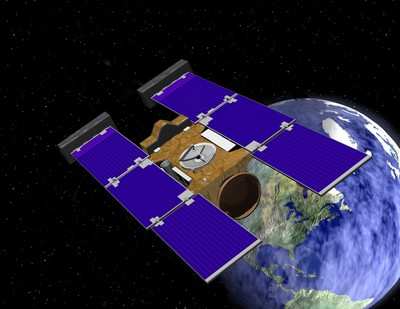Wed, Jan 14, 2009
Intrepid Spacecraft Enroute To Rendezvous With Comet Tempel
1
On January 14, NASA's Stardust-NExT spacecraft will fly by Earth
during a gravity assist maneuver that will increase its velocity
and sling shot the spacecraft into an orbit to meet up with comet
Tempel 1 in February 2011.

Flight operations for the spacecraft are performed from Lockheed
Martin's Mission Support Area in Denver, CO. The Jet Propulsion
Laboratory in Pasadena, CA provides the precision navigation need
for the flyby and the journey to Tempel 1.
The Lockheed Martin-built spacecraft's closest approach will
happen at 12:33 p.m. MST as it comes within 5,690 miles of
Earth. At its closest point, the spacecraft will fly over the
California/Mexico border south of San Diego at a speed of
approximately 22,400 miles per hour (36,000 kilometer per
hour).
"We performed our final trajectory correction maneuver on
January 5 that put us into a precise position for the flyby," said
Allan Cheuvront, Stardust-NExT program manager at Lockheed Martin
Space Systems Company. "On January 10, we sent the last set of
commands to the spacecraft that it will use to perform the gravity
assist maneuver. We're in great shape and we're looking forward to
seeing Stardust fly by before it heads back into deep space."
This isn't the first time Stardust has flown by Earth. The first
was January 15, 2001 when it used the Earth for a gravity assist to
meet up with comet Wild 2. Five years later on January 15, 2006,
the spacecraft flew by Earth
as it released its sample return capsule safely back to
Earth, which held particles from comet Wild 2 and
interstellar dust.
The Stardust-NExT (New Exploration of Tempel) mission is a
low-cost mission that will expand the investigation of comet Tempel
1 initiated by NASA's Deep Impact spacecraft. The mission uses the
still-healthy Stardust spacecraft to perform a flyby of comet
Tempel 1 and obtain high-resolution images of the coma and nucleus,
as well as measurements of the composition, size distribution, and
flux of dust emitted into the coma. Stardust-NExT will also provide
important new information on how Jupiter family comets evolve and
how they formed 4.6 billion years ago.
More News
Pilot Applied Full Aft Stick And Nose-Up Trim, But The Airplane Remained On The Runway Analysis: The pilot reported that a preflight inspection and flight control checks revealed n>[...]
A Few Questions AND Answers To Help You Get MORE Out of ANN! 1) I forgot my password. How do I find it? 1) Easy... click here and give us your e-mail address--we'll send it to you >[...]
From 2022 (YouTube Edition): Before They’re All Gone... Humankind has been messing about in airplanes for almost 120-years. In that time, thousands of aircraft representing i>[...]
Advanced Air Mobility (AAM) A transportation system that transports people and property by air between two points in the NAS using aircraft with advanced technologies, including el>[...]
Aero Linx: MQ-1B Predator The MQ-1B Predator is an armed, multi-mission, medium-altitude, long-endurance remotely piloted aircraft that is employed primarily as an intelligence-col>[...]
 NTSB Final Report: Douglas A-4K
NTSB Final Report: Douglas A-4K ANN FAQ: Q&A 101
ANN FAQ: Q&A 101 Classic Aero-TV: PBY Catalina--From Wartime to Double Sunrise to the Long Sunset
Classic Aero-TV: PBY Catalina--From Wartime to Double Sunrise to the Long Sunset ANN's Daily Aero-Term (07.01.25): Advanced Air Mobility (AAM)
ANN's Daily Aero-Term (07.01.25): Advanced Air Mobility (AAM) ANN's Daily Aero-Linx (07.01.25)
ANN's Daily Aero-Linx (07.01.25)



